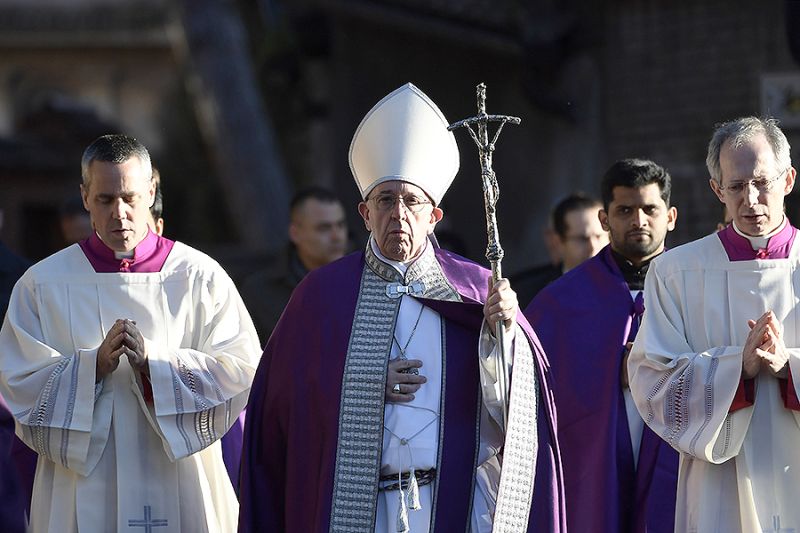
• Mt. 21:1-11
• Is 50:4-7
• Ps 22:8-9, 17-18, 19-20, 23-24
• Phil 2:6-11
• Mt 26:14-27:66
“For the infant Church, ‘Palm Sunday’ was not a thing of the past,” wrote Benedict XVI in Jesus of Nazareth: Holy Week (Ignatius, 2011). “Just as the Lord entered the Holy City that day on a donkey, so too the Church saw him coming again and again in the humble form of bread and wine.”
Today’s readings focus our attention on the connection between Jesus’ humble entrance into Jerusalem on a lowly donkey and his loving gift of the Eucharist, which he instituted prior to his Passion and death. “At the Last Supper, on the night when He was betrayed, our Savior instituted the eucharistic sacrifice of His Body and Blood”, states the Vatican II Constitution on the Sacred Liturgy, “He did this in order to perpetuate the sacrifice of the Cross throughout the centuries until He should come again, and so to entrust to His beloved spouse, the Church, a memorial of His death and resurrection: a sacrament of love, a sign of unity, a bond of charity, a paschal banquet in which Christ is eaten, the mind is filled with grace, and a pledge of future glory is given to us” (par. 47).
Taken together, today’s readings present us with two essential, yet mysterious, movements or patterns: one vertical and the other horizontal, each centered on Jesus Christ.
The vertical movement is between heaven and earth, from divinity to humanity—and back. “Christ Jesus, though he was in the form of God, did not regard equality with God something to be grasped” wrote St. Paul in the great Christological hymn in his letter to the Philippians. The Son of God came in the “form of a slave” and humbled himself, accepting the cruelty of death on the cross. This, of course, was a most astounding, unexpected descent, flowing from the love the Father and the obedience of the Son.
In the eyes of the world, the cross was complete and utter defeat. But, as Benedict noted, “The hour of the Cross is the hour of the Father’s true glory, the hour of Jesus’ true glory.” Because of his loving obedience, Paul explained, Jesus was greatly exalted and given the name that “is above every name”. And to what end? For the confession of every tongue that Jesus is Lord and for the glory of the Father. The descent of the eternal Word into the world results in the ascent of the Incarnate Word into the heavenly realms, opening the doors of life for all those united to him in faith.
The horizontal movement is from the Old Covenant and the Old Israel to the New Covenant and the New Israel. Prior to his entrance into the holy city on a donkey, Jesus had kept silent about the fact that he was the Christ (cf. Matt. 16:20). But his entrance purposefully revealed that he was the Davidic king and Messiah promised by the prophet Zechariah: “Rejoice heartily, O daughter Zion, shout for joy, O daughter Jerusalem! See, your king shall come to you; a just savior is he, Meek, and riding on an ass, on a colt, the foal of an ass” (Zech 9:9).
The pilgrims who accompanied Jesus cried out, “Hosanna” (that is, “Save us!”), sang the praises of the Son of David, and told the unsettled city dwellers: “This is Jesus the prophet, from Nazareth in Galilee.” But, just as Jerusalem had been greatly troubled by the news of Jesus’ birth (Matt 2:2-3), the city was upset by this display of joyful praise; the stage was set for the arrest and crucifixion of Christ, where the vertical and horizontal movements would meet—on the Cross.
The King of kings comes to the New Israel—the Church—in the sacraments of the New Covenant. In the sacrament of the Eucharist he comes in the humble form of bread and wine, hidden from the world but visible to those who say in faith, “This is Jesus. Hosanna! Save us!”
(This “Opening the Word” column originally appeared in the April 17, 2011, edition of Our Sunday Visitor newspaper.)
If you value the news and views Catholic World Report provides, please consider donating to support our efforts. Your contribution will help us continue to make CWR available to all readers worldwide for free, without a subscription. Thank you for your generosity!
Click here for more information on donating to CWR. Click here to sign up for our newsletter.







Leave a Reply